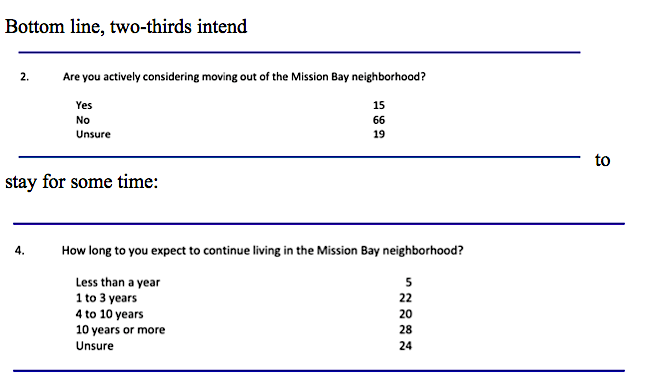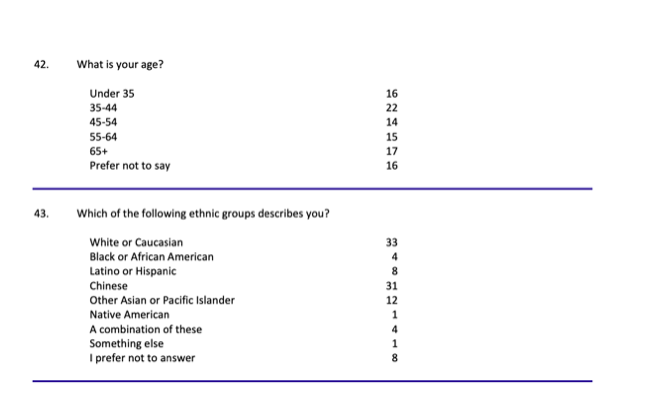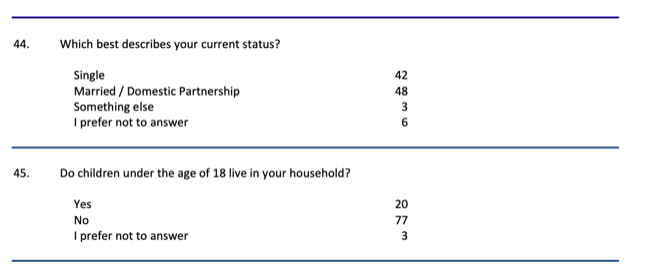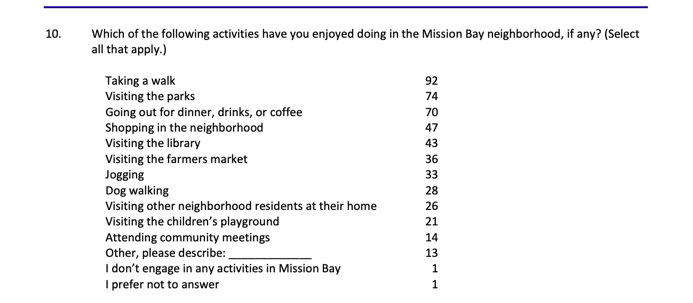The mission statement of San Francisco’s TODCO Group is South of Market Neighborhood Builders. This May, on TODCO’s behalf, David Binder Research mailed a tri-lingual mail-back/on-line resident survey to all 3,529 households within the City’s almost-completed new Mission Bay neighborhood adjacent to Soma. The goal was to learn from the residents of this completely brand-new master-planned 300-acre development district, constructed over the last 20 years at the location of the city’s long-gone railyards, if it is in fact becoming a genuine neighborhood, a real community.
Nine percent of the households—319 residents—responded. A solid majority, 58 percent, are optimistic but feel more is needed before Mission Bay will be a real neighborhood. As one responded: “It has a lot of potential to be a real neighborhood but still feels very new/needs to mature more. It hasn’t been around enough to have had long term residents/a feel of culture and community like some other neighborhoods, but it has a good foundation so far.”

Another agreed, but observed: “No sense of community, no places to gather in public and interact with others to develop a sense of community besides the Channel Park.” Yet many are hopeful: “Once the master plan is laid out and the channel park in front of One Mission Bay is completed and the project next to Oracle Park as well as the park in front of Chase Center MB will be a solid neighborhood.”
And 24 percent are even more positive, feeling this goal has already been achieved. “I think there’s a neighborhood feel with anchor venues/retail/ entertainment/gathering spaces. I think we need to tweak some items, but there’s a good spirit here,” one concluded.
But 18 percent are unsure or pessimistic. A resident noted: “I don’t really feel the coziness or culture of a community here. So many outsiders with the train station, stadiums, and traffic. I like the vibe on 4th street and the creek, but everything feels very separate here.” Another was blunt: “Just a bunch of random buildings. No one putting down long-term roots… just passing through.”

The survey reached a full cross-section of Mission Bay’s resident population:

Affordable Housing residents are well represented:

The results showed a wide range of income levels, with 48 percent employed in technology, but also documenting the reality of the “Missing Middle” who cannot afford the market housing but are ineligible for the affordable housing:

With households typical of the Central City:

But with limited social engagement among them:

Nearly all take advantage of Mission Bay’s new amenities:

But still hope for more:

Muni is well liked by 60 percent. But parking meters (55 percent negative), constant construction (53 percent), and traffic (43 percent) are not.
Ultimately, in response to the Survey’s very first question, a full 85 percent expressed satisfaction with living in Mission Bay:

The many comments offered by residents depict a wide range of individual experiences in Mission Bay. The most critical are from those intending to leave:
“Bland, lack of planning & management + sinking sidewalks.”
“Lack of shops/restaurants/etc. to walk to. Aside from Spark Social it’s pretty dead.”
“Looking for a more established SF neighborhood with a sense of community, with a variety of shops (not just bars), not a concrete jungle, and where residents are older. The Mission Bay neighborhood is primary people in their 20’s or early 30’s, whereas I am in late career.”
“Too corporate feeling. Not enough family-owned shops, reasonably priced options for groceries and shopping.”
Mission Bay’s extensive master-planned open spaces are certainly the district’s highlight:
“A lot of outdoors space that’s dog friendly and kid friendly.”
“Easy access to natural environment, trees, water, parks, community spaces.”
“Extremely walkable neighborhood.”
“How clean and walkable the area is.”
“I like the fact that the area is close to the bay where I can be close to water. Also public transit and 280 close by are good for easy commute.”
“Pedestrian plazas and parks.”
“The creek and boardwalk, central in the city, feels away and right in the middle of the city at the same time.”
As with all city neighborhoods, homelessness is a frequent concern. And Mission Bay’s newness and scale is itself a troubling factor:
“Can feel a bit empty/sterile.”
“Everything is new, not much character, no real ‘culture’ here.”
“Lack of affordable grocery choices, restaurants, no community center.”
“Lack of charm.”
“Lack of sense of community, doesn’t feel much a permanent neighborhood, not many restaurant/bar/entertainment options within walking distance, small late-night presence, lack of community events (e.g. farmers market), isolation from other SF neighborhoods, not safely bikeable to other parks.”
“No community events, block parties, etc.”
“No real community/neighborhood vibe.”
From the comments, the most commonly-desired neighborhood businesses are certainly restaurants and personal services, including pet services.
There were no major differences in survey responses between market-rate housing residents and affordable housing residents (42 percent of those surveyed). A full 30 percent of Mission Bay’s new housing is affordable housing. Unsurprisingly, affordable housing residents are somewhat more likely to stay in Mission Bay and somewhat more price sensitive about neighborhood shopping and restaurants, but not dramatically. In response to the ultimate Neighborhood question:

And similarly, there not significant differences between the responses of Residents of Color (60% of those surveyed) and White Residents. For the same ultimate Neighborhood question:

In sum, the residents of Mission Bay are genuinely optimistic about its future as a Neighborhood – but it is still very much a Work In Progress.
Mission Bay is a former Redevelopment Project approved in 1997, now under the jurisdiction of the City’s Office of Community Investment and Infrastructure. Its institutional infrastructure is very limited. Two OCII community facilities districts manage its public parks and spaces. And the Mission Bay Citizens Advisory Committee provides feedback to OCII about development plans and project regulations at its monthly meetings.
But unlike many San Francisco neighborhoods, there are no other organized and funded local institutions addressing neighborhood needs or sponsoring local activities. Unlike the former Yerba Buena Project Area nearby, there is no community benefit district to support local businesses and provide cleanup and security support And the Mission Bay community facilities districts do not provide a range of programs and entertainment, arts and cultural events and celebrations, within its public open spaces like the Yerba Buena Gardens Conservancy does not far away.
And despite the presence of a half-dozen nonprofit affordable housing operators, each individually providing social services to their own tenants within their properties, there is no overall consortium to pool resources and centralize neighborhood services like One Treasure Island) does for the master-planned Treasure Island redevelopment project now underway that also began in the 1990’s. There is no Mission Bay community center like OTI’s Ship Space. And despite the enormous Mission Bay workforce, there is no coordinated local job program for residents to take advantage of that opportunity, unlike OTI’s Job Broker program.
In sum, there are no institutionalized local and collective identity-building and community-building efforts in Mission Bay now. There is no annual “Mission Bay Day” celebration with the participation of all. There are no neighborhood fairs or street fairs or art fairs. There is no free entertainment in the parks or music on the sidewalks. There are no special civic gatherings. There is no organized fun.
The focus of the last 20 years has been building Mission Bay’s lovely parks and dozens of substantial buildings. Now that this is almost done and the new school is coming, the challenge of its next years needs to be building the Mission Bay community’s capacity to bring all its potential neighborhood spirits to life. That job is just beginning.



